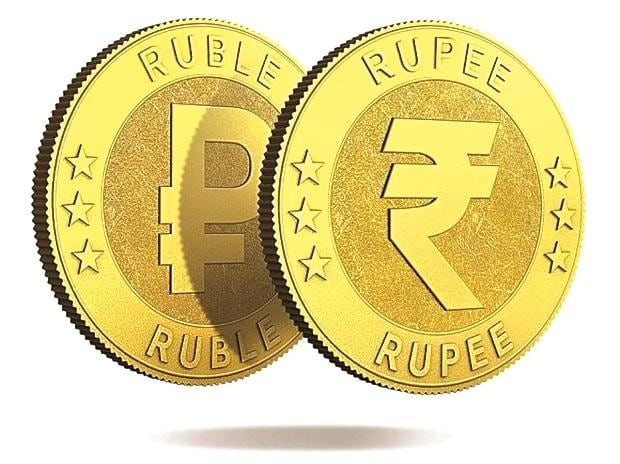Description

Disclaimer: Copyright infringement not intended.
Context
- India and Russia have established a mechanism for rupee-rouble trade.
Background
- In the wake of the Russian invasion of Ukraine, the European Union has prohibited global transactions with Russian entities using euro-denominated banknotes, while the U.S. has cut off Russia’s access to the U.S. Dollar. This has made India, which continues to trade with Russia, consider reviving the Rupee-Rouble mechanism, previously used in 1953.
.jpeg)
What is the Rupee-Rouble mechanism?
- The Rupee-Rouble trade arrangement is an alternative payment mechanism to settle dues in rupees instead of Dollars or Euros. The idea was first conceived in 1953 under the Indo-Soviet trade agreement.
Under Article VI of the Indo-Soviet agreement:
- All payments between India and the then Soviet Republic USSR may be made in Indian Rupees.
- For this purpose the State Bank of the U.S.S.R. will maintain one or more accounts with one or more commercial banks in India authorised to deal in foreign exchange. In addition, the State Bank of the USSR will, if that Bank considers necessary, maintain another account with the Reserve Bank of India.
- All commercial transactions to be financed in Rupees will take place through the commercial bank accounts while the account with the Reserve Bank of India will be used only for replenishing the balances with the commercial banks when necessary
- Payments made to and by Indian residents and USSR residents will be done only in those specified accounts by debiting/crediting.
- The accounts will be replenished by (a) by transfer of funds from another account of the State Bank of the USSR with another commercial bank or with the Reserve Bank of India; or (b) by the sale of Sterling to the bank concerned.
Centre on reviving Rupee-Rouble mechanism
- Within a month of the start of the Russia-Ukraine war on February 24 2022, external affairs minister S. Jaishankar had indicated in Parliament that the government was examining ways to revive the rupee-rouble trade mechanism that was provided for in the Indo-Soviet Trade Agreement of 1953 to deal with the US and the European Union barring transactions with Russian entities in the dollar and the euro.
- And now, the mechanism of rupee-rouble trade has been established. It is now for the banks to use it.
- Russian delegation may visit India in May to discuss Rupee-Rouble payment mechanism.
Why revive Rupee-Rouble trade?
- Over 40 U.S. and European allies have imposed economic sanctions against Russian banks and entities amid the war in Ukraine.
- Indian exporters are awaiting payments of about $500 million that have been delayed amid the sanctions.
- According to the Department of Commerce, India has imports worth Rs. 64,623 crore from Russia in 2021-22, which is 59.04% growth from last year. This constituted 1.58% of the total imports of India.
- Moreover, India’s exports to Russia is worth Rs 23,658 crores in 2021-22, which is a 20.4% growth since last year. India’s total trade with Russia amounted to Rs 88,281 crores in 2021-22, which is a 46.45% growth. In total, India-Russia trade is worth RS 68.98 lakh crores — a mere 1.28% share of India’s trade figures.
- India’s trade deficit with Russia amounts to Rs 12.83 lakh crores, which include crude oil, defense trade.

What are the problems that may crop up?
- The fluctuation in the value of rouble could make it difficult to implement the rupee-rouble payment mechanism. Firstly, it will be difficult to decide a fair exchange rate between the rupee and the rouble.
- Moreover, if the value of the rouble continues falling sharply, then trading may not happen as the rouble in the Indian bank’s Russian account will lose value. This is a risk that India will have to take if it decides to go ahead and put a rupee payment mechanism in place.
What are the strategic ramifications for India? Will the world see this as an arrangement by India to by-pass the sanctions post-Final Thoughts
- If the sanctions turn product-specific, then it may be difficult for India to use this arrangement.
- The US and the EU are already unhappy with India for abstaining at the UN Security Council and the UN Human Rights Commission on all resolutions that criticise Russia for invading Ukraine. On top of that, if India helps Russia flout economic sanctions, it may then be accused of siding with Russia and this could hurt New Delhi’s diplomatic relations with the Western powers.
Significance of the Rupee-Rouble mechanism
- It is important for India to have an alternative payment mechanism in place with Russia as the US, the EU and the UK have blocked at least seven Russian banks from accessing the Society for Worldwide Interbank Financial Telecommunication (SWIFT). SWIFT is a global secure interbank system that communicates payment instructions and enables transactions between banks from all the countries around the world.
- An estimated $500 million is pending for goods already shipped by Indian exporters and it is now not possible to get the payment through the regular SWIFT channel. Since transaction with Russia cannot be carried out in international currencies such as the dollar or the euro, a rupee payment mechanism could play a pivotal role in deciding whether Indian exporters will get their payments and if trading can be continued with Russia.
Read: https://www.iasgyan.in/daily-current-affairs/countering-americas-adversaries-through-sanctions-act-caatsa


https://theprint.in/india/rupee-rouble-mechanism-for-india-russia-trade-established-envoy/1357794/#:~:text=The%20Rupee%2DRouble%20payment%20system,be%20on%20the%20safe%20side.
















